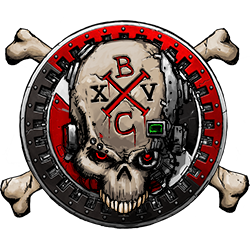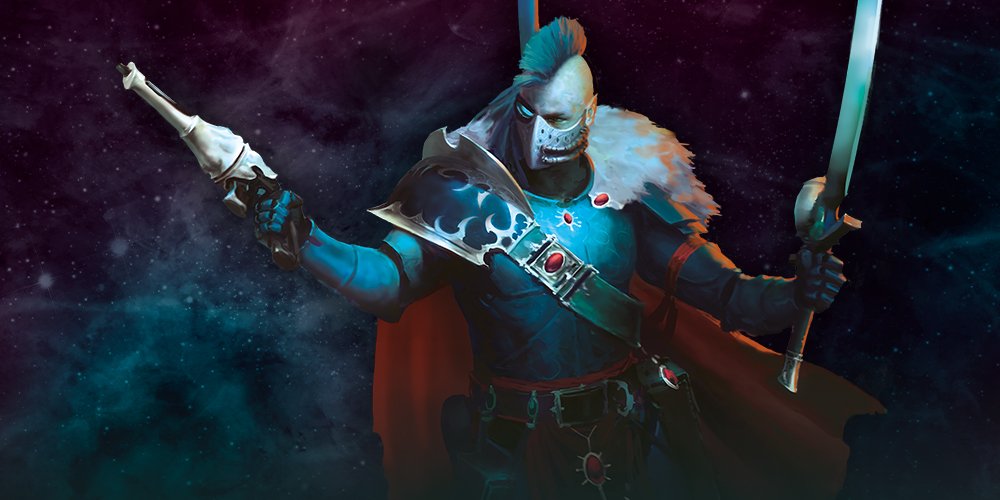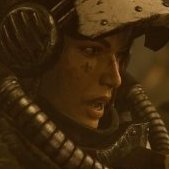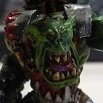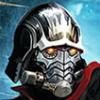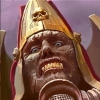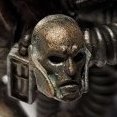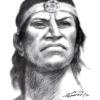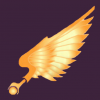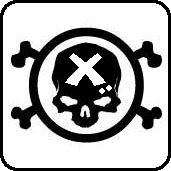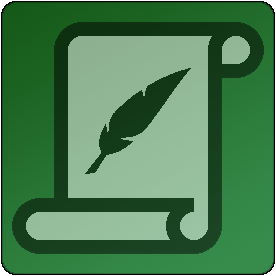-
Posts
812 -
Joined
-
Last visited
About Ioldanach

Profile Information
-
Location
Lost in shadow on the Path of the Outcast
Previous Fields
-
Armies played
Aeldari, Adeptus Astartes
Recent Profile Visitors
1848 profile views
Ioldanach's Achievements
-
 Ioldanach reacted to a post in a topic:
Blog Categories
Ioldanach reacted to a post in a topic:
Blog Categories
-
 Ioldanach reacted to a post in a topic:
=][= THE EMPEROR'S CHILDREN FORUM HAS ARRIVED, AND BLOGS HAVE CHANGED =][=
Ioldanach reacted to a post in a topic:
=][= THE EMPEROR'S CHILDREN FORUM HAS ARRIVED, AND BLOGS HAVE CHANGED =][=
-
 Ioldanach reacted to a post in a topic:
A Corsair Army is sooo....frustrating
Ioldanach reacted to a post in a topic:
A Corsair Army is sooo....frustrating
-
 ZeroWolf reacted to a blog entry:
The Rest of the Story (sort of...)
ZeroWolf reacted to a blog entry:
The Rest of the Story (sort of...)
-
Ioldanach started following Forgery! , The Rest of the Story (sort of...) , The Throne Knights and 7 others
-
I suppose it's time to tell you as much of the rest of the story as I can. While I had originally intended to present a story in which you never quite knew whether or not the Accusers existed, I mucked that up in telling the Homecoming story. It was such a compelling vignette, though, that I couldn't resist telling it and spoiling the secret. Yes, the Accusers existed. They were created in the 2nd Founding and were one of the Primogenitors. While many of the members of the chapter may have been inducted at the tail end of or after the Horus Heresy, perhaps serving during the Scouring, the senior members of the chapter were veterans of the Great Crusade and the Horus Heresy. Led by Astinax Megaeros, a chapter master in the Ultramarines Legion and first (and only!) Chapter Master of the Accusers Chapter, the Accusers embarked on the core mission of the Scouring: pursuing and destroying the traitor legions. They participated in the combined action of multiple Ultramarines Legion successors at Tsagualsa. After the apparently mortal wounding of Roboute Guilliman by Fulgrim and the subsequent placement of the former in stasis upon Macragge, Megaeros, utterly devoted to his gene-scion, led his chapter in a crusade against the traitor legions. Slowly, Megaeros descended into an existence of wrath and hatred, the majority of his chapter willingly following his lead. Eventually, however, some members of his chapter resisted and the chapter was broken by a schism. Megaeros and his followers were defeated, though we don't know of Megaeros's fate. The mystery, then, is why we've never heard of this chapter; and what became of the loyalists. The answer in my mind is that the Ultramarines and their Primogenitors are not as squeaky clean as many suspect, and that they, too, are capable of subterfuge and deception. In this case, the Ultramarines and their successors decided to pretend as if the Accusers never existed, destroying all evidence to the contrary. The code word for this is the Corrigere Sanction, whose meaning is known only to the Primogenitors (including the Ultramarines Chapter). This means that any records of the Accusers' existence were either destroyed or hidden away. Yes, this throws the pedigree of the Apocrypha of Skaros into question (though the official expansion of the 2nd Founding, which happened after I created this chapter, has already done that). Just as the Unforgiven chapters hunt for the Fallen, the Ultramarines and other Primogenitors follow the Corrigere Sanction in concealing the existence of one of their own falling to Chaos. From an in-universe perspective, the fall of the Accusers would be only the first of multiple scions of Roboute Guilliman to fall to Chaos over the millennia, but it was a traumatic event for Guilliman's sons at the time. For what it's worth, the sword described in the Homecoming story, which was presented to Astinax Megaeros by Roboute Guilliman upon the chapter's founding, was recovered and returned to the Ultramarines. That sword is now known as the Talassarian Tempest Blade and is currently borne by Cato Sicarius, the Commander of the Victrix Guard. How that sword returned to the Ultramarines is not my tale to tell. I previously mentioned that the Accusers present me with a ready-made chapter if I ever do a force for the Scouring. Knowing that some of them fell to Chaos, it should be obvious that the Accusers also present me with an opportunity to create my own Heretic Astartes warband, perhaps even one that operates during the Era Indomitus. I had an idea when I first started working on the story, but I was approached by another member of the B&C community who had an idea for a DIY chapter that meshed quite well with what I was working on. We decided to combine our efforts. No, I won't tell you who that member was, nor will I tell you the name of their chapter. It has been over a decade since I corresponded with them, but as far as I'm concerned, the intertwined story that we collaborated on remains as valid now as it was over a decade ago. The tale of what happened to the loyalist Accusers, whether or not they still exist in the Era Indomitus, and what they've been up to over the intervening millennia is theirs to tell. This whole idea was an interesting exercise. The return of Roboute Guilliman to the Imperium creates risk for this DIY, however. After all, the Primarch almost certainly remembers Astinax Megaeros and the Accusers Chapter; and he most likely recognized the Talassarian Tempest Blade wielded by Cato Sicarius as the weapon he once bestowed upon his devoted son. Would Guilliman seek answers from the Ultramarines, who likely have the records hidden away deep within their librarium? Would the Accusers be reborn as a Primaris chapter in the Ultima Founding? Or should I just consider this one of those fan-fiction DIYs that can't exist as true "canon" since the official lore ignores them, implying that they never existed? Or should I entertain the pipe dream that GW might some day incorporate the Accusers into the official lore (I won't hold my breath )? But really, what happened to the loyalists?
-
- Accusers Chapter
- Primogenitor
-
(and 2 more)
Tagged with:
-
GENE-SEED (PREDECESSOR): Dark Angels (Angels of Vengeance)FOUNDING: unknownCHAPTER MASTER: Pyrrhus BrasidorCHAPTER WORLD: UrkonaFORTRESS MONASTERY: The HoldMAIN COLORS: crimson, bone, silverSPECIALITY: noneBATTLE CRY: “For the Emperor!”CURRENT STRENGTH: none (see “Present Activities” below)KNOWN DESCENDANTS: noneORIGINSThe earliest recorded actions of the Throne Knights Chapter date back to M34, in the years following the Howling. Created from the gene-stock of the Angels of Vengeance Chapter, the Throne Knights lineage ultimately derives from the 1st Legion and the primarch Lion El’Jonson. The various Unforgiven chapters were under scrutiny at this time as evidence of their willingness to abandon erstwhile allies in pursuit of their own agendas was mounting, so the choice of the Angels of Vengeance as a predecessor was unusual. In all likelihood, the Angels of Vengeance had performed a great service to the Imperium and had been rewarded with the prospect of siring a new chapter, though the nature of that service is lost to history.The Throne Knights operated as a crusading chapter for the first eight centuries after their founding, participating in operations throughout the Segmentum Obscurus, including participation in at least two of the crusades of the Adeptus Ministorum and the purging of the xenos Thal’kreen. The Throne Knights are also recorded as successfully defending against a minor Chaos incursion in the Scarus Sector; as well as re-taking the Imperial world of Johexis from renegades, an event known in latter day Imperial histories as the Bloodsword War. Librarium Note: It is worthy to note that the leader of the Chaos renegades in the Bloodsword War was the Fallen once known as Heraniel, Sword Lieutenant of the 18th Chapter of the 1st Legion. Heraniel’s broken body was recovered by the Throne Knights and submitted to the Rock following the Bloodsword War. Operating as a crusading chapter for the first few centuries of its existence, the Throne Knights Chapter claimed Urkona as their chapter world following the Jager crusade in M35. Their actions over the next two millennia are a history of warfare, ranging from the purging of space hulks to countering Ork Waaaghs. Their most famous actions by far were the Second Battle of Zurst and the Crusade of the Emperor’s Light [see below].Suffering severe casualties in the Crusade of the Emperor’s Light, the Throne Knights entered a period of rebuilding. They had been reduced down to less than four hundred battle-brothers, losing almost the entire First Company and the majority of their senior officers in the bloody fighting. Though the chapter was capable of regaining its full strength in time, some taint had insinuated its way into the chapter within the Banehold warp storm. The exact nature of the taint has never been ascertained, but it took a combined force of three full chapters to bring the errant chapter to heel. The chapter has since been listed as traitoris purgatus. Librarium Note: The Inner Circle members of the Throne Knights Chapter waivered in their devotion to the Legion and the Hunt for the Fallen. In M580.M37, the Throne Knights rendezvoused with the Rock in the Agripinaa sector. The chapter was called to task on their Meeting with the Supreme Grand Master, the Grand Master of the Throne Knights, Pyrrhus Brasidor, questioned the need to complete the Hunt, and then claimed that his chapter’s devotion and service to the Emperor and the Imperium were sufficient to absolve them of their obligation. He cited renegades from other legions that had remained loyal to the Emperor and pointed out that the chapters descended from those legions remained in the good graces of the High Lords of Terra. He was immediately censured by the Supreme Grand Master. The Throne Knights Grand Master retired to the Imminent Fury with his honor guard and returned to Urkona, indicating that his chapter was autonomous and answered to no one but the Emperor and the High Lords of Terra. After this event, the Throne Knights refused to respond to the missives of the Supreme Grand Master. Worse yet, the Throne Knights Chapter had developed a known relationship with members of the Inquisition following the Bagrattius crusade. Fearing that the Throne Knights would reveal the existence of the Fallen and doom the Unforgiven chapters, the combined Inner Circle decided to act. Three entire chapters were mobilized, recalling all subordinate forces that had been deployed. The combined force then journeyed to the Nikor system and launched an assault on Urkona. Catching the Throne Knights Chapter off guard, the combined force succeeded in destroying the Throne Knights to the last man, though not without casualties. Though the gene-seed stores of the Throne Knights were divided equally between the three chapters, the Angels of Vengeance refused to accept what they considered to be tainted gene-seed. Their share was taken by the Dark Angels for distribution among the Unforgiven chapters as they saw fit. The fortress-monastery of the Throne Knights was then destroyed by orbital bombardment. Knowing that the destruction of the wayward chapter could not remain a secret, the Dark Angels submitted a report to the High Lords of Terra describing how the Throne Knights had succumbed to moral corruption and heretical practices, submitting several Warp-infused relics recovered from the chapter’s librarium as proof. The High Lords of Terra accepted the explanation and commended the three chapters for the action. The remaining relics of the chapter were seized by the Dark Angels and taken to the Rock for destruction. CHAPTER HOME WORLDOnce an ocean world completely covered in water, Urkona had collided with a rogue planet billions of years before mankind had first crawled from the sea on Holy Terra. The rogue planet was destroyed in the collision, its raw material breaking apart and sinking into the depths of Urkona. The force of the collision forced Urkona off its orbit, thrusting it to the extreme edge of the life-supporting region of the star Nikor before its orbit stabilized. Most of the lifeforms indigenous to Urkona suffered extinction as a result of the planetary collision and shift in climate, but a few hardy species survived. Moreover, alien material introduced by the rogue planet evolved into a variety of new species able to survive the deadly frigid ecology.Urkona was originally settled by Mankind during the Dark Age of Technology. The settlers were eventually reduced to a pre-industrial technology level and their colony ships were salvaged to fabricate city-state dwellings deep beneath the icy surface of the planet. Cut off from the rest of mankind during the Age of Strife, the human colonists developed into a caste-based feudal culture. The most important of the castes were the Structors and the Venati. The Structors were responsible for the building and maintenance of the city-states and their life support systems while the Venati were a warrior-hunter caste. Initially responsible for hunting on the surface to provide food for their city-states, the scarcity of native fauna and competition with other city-states inevitably led to open warfare between the city states. The city-states were eventually reduced to just five, but the separation between the surviving city-states reduced competition for food and resulted in minimal warfare between the survivors. This balance of power remained stable through the Age of Strife.Urkona was rediscovered by mankind during the Jager crusade when renegade forces sought to escape the forces of the Imperium. Pursued by a small force of Throne Knights Space Marines, the renegades were ambushed by a Venati hunting party. Though the Venati were wiped out to a man, they succeeded in killing far more of the better equipped renegades. Impressed by the prowess of the Venati, the Throne Knights Chapter claimed the world as their own, establishing the fortress monastery in an orbital station.The Throne Knights remained aloof from the surface of their planet, descending only to conduct training and to recruit neophytes. The inhabitants of Urkona remained largely ignorant of the Throne Knights Chapter, knowing only that Venati often disappeared while on the hunt [see Recruitment].When the combined force of the Dark Angels, Angels of Redemption, and Angels of Vengeance destroyed the Throne Knights Chapter, the Venati hunting parties on the surface of Urkona saw, but failed to understand, the great battle taking place in orbit above them. When the orbital fortress of the Throne Knights crashed to the surface of the planet, destroying one of the city-states, the Venati knew only that the fiery wreckage had destroyed their city-state. The survivors fled to the nearest enemy city-state, seeking refuge. Captured and tortured, they told their tale to their disbelieving fellows in the city-states beneath the ice. Further hunting parties confirmed the destruction of the city-state and the tale has grown into an oral lesson about the anger of the Sky Gods, spreading to all of the Urkonan city-states.To this day, Urkona remains a minor recruiting world of the Angels of Redemption chapter.PRESENT ACTIVITIESThe Throne Knights Chapter was destroyed in mid-M37 by a combined force of the Dark Angels, Angels of Redemption, and Angels of Vengeance Chapters in an action that has been recorded as the Judgment at Urkona.BATTLE HONORSThe watershed events of the Throne Knights Chapter were the Second Battle of Zurst and the Crusade of the Emperor’s Light.Second Battle of ZurstThe Second Battle of Zurst was a battle of the Stonefist War which took place in M36, in which the Throne Knights under Master Mykenon destroyed the Tagus landing fields. The landing fields were the essential destination of any ships traveling through the Drewlian Gate, a stable passage through the Warp.The renegade leader, Hehrn Rodnar, was a chief lieutenant under the arch-traitor, Hraz Stonefist. His forces had successfully captured the strategic worlds of Almanaras III and Kadr Fein, commanding the major route between the Antimar and Ange Lus sub sectors. He now prepared to advance into the Ange Lus sub sector with a massive force of renegades, which was strong enough to take on the Astra Militarum forces in the segmentum. There were two Throne Knights detachments operating in the Ange Lus subsector, however: Strike Force Mykenon, on patrol near Heveron, and Strike Force Eumaios en route to Thracian Primaris. The Drewlian Gate separated the two sub sectors. Any military force moving between the two sub sectors would have to cross through the Drewlian Gate to the Tagus landing fields.The renegades had strengthened the position at the landing fields by securing the orbital defenses, a network of orbital weapons platforms that created a gauntlet of interlocking fire between the Drewlian Gate terminus and the atmosphere of Kadr Fein.The two Throne Knights strike forces linked up near Ingeran and Mykenon, as the senior officer, assumed command of the overall force. Mykenon’s plan involved dividing his force into three elements. The largest element was under his direct command and was to storm the landing field at Kadr Fein from the north. The second element under Master Eumaios was to attack the near-orbit defenses while the third element under Sergeant Telanicus was to launch a diversionary attack on the south end of the landing fields.The attack on the south end of the landing fields began at dawn when devastators opened up against the bastion at Morbat. The defenders were prepared for the assault but were still taken by surprise when centurions and assault squads burst from their cover and charged up towards the bastion in the face of fire from the defenders. Soon the opposing sides were engaged in hand-to-hand fighting.Observing the assault, nearby renegades moved to reinforce the remote bastion. This action succeeded in diverting the attention of the renegades, enabling Master Mykenon’s force to launch the main attack on the opposing end of the landing field. Meanwhile, the Throne Knights fleet under Master Eumaios was weathering orbital defense fire while destroying most of the network of orbital guns. This prevented the forces in orbit from firing upon the Throne Knights forces engaged on the planet below.The action was swift-moving, deceptive and daring. The decisive result produced a substantial improvement in the Imperial position by keeping renegade forces separated ahead of the imminent Battle of Heveron. Sergeant Telanicus was grievously wounded in the fighting and was later interred in a dreadnought sarcophagus, continuing to serve the chapter for seven centuries. Master Mykenon delivered the deathblow to Rodnar in single combat, depriving Stonefist of one of his most tactically adept subordinates.Crusade of the Emperor’s LightThe Crusade of the Emperor’s Light was part of the Wars of Apostasy in M37 when the forces of the Imperium fought to regain control of worlds that had broken from the Imperium during the Reign of Blood.The Ecclesiarch sought principally to recover shrine worlds and stamp out pockets of those still loyal to Goge Vandire. The Adeptus Ministorum forces, spearheaded by the Adepta Sororitas under the leadership of Alicia Dominica, were joined by multiple contingents of the Astra Militarum and Imperial Navy. Several Adeptus Astartes Chapters seconded detachments to support the crusade, among which was a strike force of the Throne Knights Chapter under Master Urkaenos.The crusade succeeded in regaining control of over thirty worlds, including four shrine worlds of the Ecclesiarchy. The Throne Knights were heavily involved in the fighting for two of the shrine worlds. More importantly, Master Urkaenos personally led a force that reinforced Sister Dominica’s contingent after it had been cut off by surprise reinforcements. Though Master Urkaenos later died in battle at the Invasion of Talvisota, his leadership and prowess throughout the crusade were reported to the Ecclesiarch by Sister Dominica. The Throne Knights Chapter was awarded a Victorix Maxima upon completion of the holy crusade and the Ecclesiarch had a statue erected to honor Master Urkaenos at the Convent Sanctorum. Librarium Note: The Throne Knights reported multiple battles in which they faced traitor Adeptus Astartes during the Crusade of the Emperor’s Light. None of those they encountered were of the Fallen, nor were they thought to have known of the Fallen. The Throne Knights reports highlighted the fact that one of the traitor forces they encountered appeared to be renegade Iron Hands Space Marines. CHAPTER ORGANIZATIONThe Throne Knights chapter was organized similarly to the other chapters descended from the Dark Angels Legion. While this was similar in most respects to standard Codex Astartes chapter organization, there were several distinct differences.The first two companies of the Throne Knights are where the greatest differences from other codex chapters resided, mirroring the organization of other successors of the 1st Legion. As with the Dark Angels chapter, the 1st Company of the Throne Knights was known and feared as the Deathwing, veterans who only took to the field of battle in tactical dreadnought armor. Similarly, the 2nd Company was the Ravenwing, and those who made up its ranks were masters of high speed attack - every warrior rode a bike, land speeder, or atmospheric craft.The remainder of the chapter was organized along strict codex lines, with the 3rd, 4th, and 5th Companies forming the battle companies; the 6th, 7th, 8th, and 9th the reserve companies; and the 10th Company consisting of scouts. Librarium Note: As with other Unforgiven chapters, the most senior leaders of the Throne Knights formed the Inner Circle. The membership of the Inner Circle included the Grand Master, the Masters of the Deathwing and Ravenwing, the librarians, the interrogator-chaplains, and select senior company masters. FLEET ASSETSThe Throne Knights maintained a modest fleet, having only a single battle barge, the Imminent Fury, and four strike cruisers. In addition, the Throne Knights operated the Spear of Retribution, which was larger than a standard strike cruiser and able to embark a force twice the size of that which a standard strike cruiser can embark. The Spear of Retribution appeared to be a heavily modified version of a Lunar class vessel, though how and where the Throne Knights acquired this ship is unknown. The Imminent Fury Battle barge Chapter flagship RECRUITMENTThe Throne Knights employed a unique method of recruitment that also served as a test for veterans. Induction into the chapter’s veteran company took place only once a year. Each year, a handful of battle-brothers were submitted as candidates the veteran company. These candidates were assigned as pairs. Each pair of battle-brothers was inserted into the icy wastes of Urkona wearing only protective cameleoline clothing and equipped with homing beacons for their own use and as well as other supplies. Each pair would first construct a camouflaged shelter, using the shelter as a base of operations. They would then hunt the Venati hunting parties, stalking them and taking the youngest for the chapter. Once the first of the neophytes had been seized, one of the candidates would remain at the shelter as guard while the other would continue the hunt. They would then take it in turns, one using the provided supplies to keep the neophytes alive and protected from the elements while the other would return to the hunt in order to seize another neophyte. Each pair would continue their hunt until they had gathered a half dozen neophytes or a week had passed, at which point they would activate their homing beacon and take their captured back to the chapter.On the handful of occasions in which a candidate was slain by Venati, the other candidate would subdue those of the Venati hunting party that he could while slaying the others, immediately activating the homing beacon. The entire Venati hunting party would be taken to the chapter and accorded honors. Those that were young enough would become neophytes while those too old for the process would become thralls. Chapter tradition maintained that the neophytes from such events were destined for greatness.While the candidates operated with maximum stealth when recruiting, members of Venati hunting parties occasionally snatched glimpses of the Adeptus Astartes or the remains of their shelters. To the Venati, the candidates became creatures of fear and superstition, beasts that haunted their nightmares and invoked fear. The candidates became creatures of myth – the Sarmenkar (Great Ice Devils).CHAPTER COLORSThe Throne Knights livery featured deep crimson as the predominant armor color. Chest decorations were typically in silver and both the winged skull chapter badge and common squad badges were displayed on opposing shoulder pauldrons in a bone color. Company affiliation was displayed upon the left kneepad using a distinctive system that drew upon that used by their progenitors, the Angels of Vengeance, and which could be traced back to the First Legion. Throne Knights sergeants were distinguished by black helmets rather than the usual red. Though the chapter followed the Codex Astartes closely, one minor deviation was that veterans wore bone colored helmets rather than white. Similarly, the members of the 1st and 2nd Companies were distinguished only by their bone colored helmets, squad badges, and honor markings. The chapter’s neophyte scouts displayed markings and livery that generally conformed to the dictates of the Codex Astartes. The company captains, referred to as “company masters” in a practice that paralleled other Unforgiven chapters, wore the standard rank insignia provided in the Codex Astartes. One notable difference was the additional wearing of rank shields at the left shoulder. These shields displayed the heraldry of their company and served as the basic badge of office. BATTLE STANDARDS OR CHAPTER BANNERSThe Throne Knights habitually carried banners into battle, including both unit-based standards and banners as well as personal standards. One notable type of personal banner was known as a Mortem Banner, referring to the Mortem Oath. Such an oath would be sworn to achieve a particular objective or to die in the effort. The common feature on such banners was the imagery of a skull wearing a laurel crown, representing victory in death. Master Urkaenos swore such an oath during the Crusade of the Emperor’s Light, successfully completing his oath when he struck down the leader of a traitor warband. The majority of his force was killed or injured in the action, including his banner bearer, when the traitor force was augmented by Warp-spawn. The Mortem Banner was damaged in a hell-born conflagration, but the singed remains were submitted to the Adeptus Custodes on Holy Terra when the chapter was awarded the Victorix Maxima.Shown below are pict-captures of two of the standards carried by the Throne Knights during the Crusade of the Emperor’s Light. The banner on the left was that of the 4th Company while that on the right was Urkaenos’ Mortem Banner before it was damaged. Librarium Note: While the remains of Urkaenos’ Mortem Banner are in the safekeeping of the Adeptus Custodes and beyond our reach, the 4th Company Banner pictured above was destroyed after the Judgment at Urkona.BATTLE HONORS/RELICS/DECORATIONS/AWARDSAmassing a battle history over three millennia, the Throne Knights Chapter earned many awards and commendations. The most significant of these, though, was the Victorix Maxima for the Crusade of the Emperor’s Light and the statue to Master Urkaenos at the Convent Sanctorum. The statue still stands today, one among many honoring the heroes of the Imperium that have fought alongside the Adepta Sororitas.COMBAT DOCTRINEThe Throne Knights followed normal Space Marine tactical and strategic doctrine as found in the Codex Astartes, the masterwork of the primarch Roboute Guilliman. While conforming to the broad tenets of tactical flexibility espoused within the Codex Astartes, the Throne Knights demonstrated a preference for rapid assault and first strike methods. Wherever possible, they would concentrate their forces, though they would employ combined arms with different elements of their forces converging at strategic points in order to achieve victory.The chapter typically operated as two elements. The first element comprised the majority of the chapter embarked aboard the Imminent Fury and a fleet of strike cruisers and rapid assault vessels. This element would engage in major campaigns, often crusading in furtherance of the chapter’s self-appointed mission to continue the spirit of the Great Crusade. The second element comprised a task-organized force built around a battle company. This element would also include squads from other companies, and would generally resemble a much smaller version of the first element. The second element would operate from the Spear of Retribution. At any point in time, one of the two elements would be deployed while the other would perform the dual role of defending the chapter’s home world while training, reconstituting, and preparing for deployment.LOCAL RITUALSThe warrior cult of the Throne Knights Chapter was secretive, but was known to have been heavily influenced by the hunter-warrior caste rituals of the Urkona populace. Chief among these rituals were the symbols of the hunt as well as a combination of rites featuring survival of the cold and the embrace of fire. A handful of testimonies from eyewitnesses serving alongside the Throne Knights reported considerable facial tattoos on various battle-brothers of the chapter.BELIEFSWhile the Throne Knights did not literally deify the Emperor, the strength and passion of their belief in him was equal to that of any adherent to the Imperial Cult. They believed that the Emperor represents the pinnacle of Humanity and regarded him as the founder of the Imperium and as their creator. The Throne Knights believed that the Emperor would eventually heal and rise from the Golden Throne, and would subsequently achieve total conquest of the galaxy. The chapter believed that its role was to continue the ideals of the Great Crusade, furthering the expansion of Mankind in its eventual dominance over the galaxy. The Throne Knights venerated their Primarch as much as they did the Emperor and continually strove to emulate the example of Lion El’Jonson.The Throne Knights were notoriously intolerant of non-humans and would refuse to fight alongside armies that included alien races, abhumans, and mutants. They were highly suspicious of outsiders and often appeared unreasonably aloof and intransigent. Indeed were a number of occasions where the Throne Knights withdrew suddenly and with no explanation from a warzone when confronted by an Imperial inquisitor or missionary.GENE-SEEDCreated from the gene-stocks of the Angels of Vengeance Chapter, the Throne Knights’ gene-seed was pure and showed no signs of degradation. When the Throne Knights Chapter was destroyed, the majority of the gene-seed stocks were taken by the Dark Angels Chapter, with the balance taken by the Angels of Redemption. The predecessor of the Throne Knights, the Angels of Vengeance, refused to accept any of the gene-seed, despite the losses the chapter suffered in the heavy fighting required to destroy of the Throne Knights.CHAMPIONS OF THE CHAPTERMentes Urkaenos, Master of the 4th Company, served as senior commander of Throne Knights forces during the Crusade of the Emperor’s Light. His career as an Adeptus Astartes began auspiciously when, as a young boy, he had been part of a Venati hunting party stalked by venerable brother-candidate Koratedes, and had been witnessed to be the one that struck the deathblow upon Koratedes. He was especially attentive in his devotions to the Emperor and his armor during the Crusade of the Emperor’s Light was festooned with various seals of piety, purity, and devotion. He bore the argent laurel as reward for his defense of the 4th Company Banner when xenos Eldar ambushed a Throne Knights force during the Dursk War, standing over the fallen form of Master Remneus as he held the banner aloft. His actions during that incident earned him candidacy for the Deathwing and he eventually returned to the 4th Company as Master of that company three decades later.Alkinus Mykenon was a brilliant tactician and bold leader. He favored a massive axe in battle, a mighty weapon crafted to his specifications after he had served as Chapter Champion under Grand Master Kromedes. Mykenon later became Grand Master of the Throne Knights, serving the chapter for three centuries before finally being slain during the Tethsarch Incursion. After his death, his skull was displayed in the chapter’s grand hall, the bones covered in a layer of silver inscribed with the record of his awards. Librarium Note: Mykenon’s axe was one of the items retrieved from the Throne Knights fortress monastery during the Judgment at Urkona. It was taken as a spoil of battle by the Angels of Vengeance, who purified it and bequeathed it upon the Master of the 8th Company, Master Reduel, for his bravery. Master Reduel later disappeared during the Grenuet Wars and was presumed dead, the axe disappearing with him. Mykenon’s skull was protected by heavy wards, beyond the ability of our Librarius to counter without great risk. The skull remained in the chapel and was destroyed when the fortress monastery was destroyed.
-
- Throne Knights Chapter
- Unforgiven Chapters
- (and 2 more)
-
Back in 2014, @Grand Master Belial ran the Brotherhood of Angels challenge. This was one in a series of similar annual challenges in which he challenged members to present articles showcasing their DIY Unforgiven chapters. After considering the challenge and developing my basic concept, I committed to the challenge with the following oath: (You can click on that to see it in full size) If I recall correctly, the "Throne Knights" name came from an earlier discussion, though I can't recall exactly where that discussion took place other than to suspect it was within the Liber Astartes forum. That name was not used by whoever it was that was discussing it, so I shamelessly appropriated it for my own use. I wanted to get away from names that were obviously related to the Unforgiven chapters. As with all of my DIYs, I wanted to explore a specific concept. In this case, I wanted to explore what might happen if one of the successors of the Dark Angels legion ever decided to not take part in the hunt for the Fallen. Describing such a chapter was an inherent part of the article, but my focus was really on the consequences for that chapter, as portrayed through the eyes of the other Unforgiven chapters. Spoiler: the other Unforgiven chapters didn't react well. Though I chose for the chapter to be mavericks of sorts (compared to the other Unforgiven chapters), I incorporated a lot of imagery that drew upon the traditions of the First Legion. The squad and company markings were straight out of Codex: Dark Angels, though I replaced the green of the Dark Angels with the dark red of the Throne Knights. Similarly, the broken sword motif of the Deathwing was kept, and though I didn't portray it, the winged sword motif of the Ravenwing was also present. Unlike the Dark Angels, however, the coloration of these two companies was the standard dark red of the rest of the chapter. You can see the basic livery of the Throne Knights chapter at left. I also wanted to show how this now-lost chapter was once lauded among the Adeptus Astartes. This wasn't to say that they were ever "better" than any other chapter - only that they, like other chapters, achieved victories that were worthy of recognition by the larger Imperium. To do that, I drew inspiration from the image at right, which shows the Eternity Gate on Holy Terra, with various banners of the Imperium's heroes throughout the millennia. While I generally disdain the notion that planets are ever composed of a single biome (e.g., so-called "jungle worlds" or "desert worlds" etc.), I decided to use that device with the homeworld of the Throne Knights. The mechanic for doing this was to place the planet at the extreme outer edge of the so-called "Goldilocks zone" where life can be sustained. As such, the water-rich planet had a frozen surface, the inhabitants forced to live in underground arcologies fabricated from the remnants of the ships that had originally brought them to the world during the Dark Age of Technology. As a contrast, I also incorporated facial tattoos among the Throne Knights, theoretically a practice that they borrowed from the planet's human inhabitants. The inspiration for the tattoos I used, however, came from tribes of the Amazon, a rain forest biome. I never explored the fauna of the Throne Knights' homeworld, though it was conceptually important since hunting that fauna was a key catalyst for the chapter's recruitment process. My theory was that one or more of the lifeforms that the humans of the world hunted created some substances that were used in the facial tattoos of both cultures, that of the humans and that of the chapter. I figured that the consequences of the original planet colliding with some rogue planet, the impact on the environment as Urkona was thrown off its original orbit and shifted outward from its sun, and the survival of biological matter from both planets to evolve into lifeforms that could survive the devastated environment, led to some interesting and hardy lifeforms. The facial tattoo designs were copied straight off the cover of an issue of National Geographic magazine at that time, and bringing them to fruition using the Space Marine Scout Painter was ... interesting. Unfortunately, this wasn't a chapter that I really considered much past the article stage. I know that I would like to get a few models painted up - perhaps a kill team or maybe a combat patrol (I'd love to finish a company master and some terminators, after all). It was more of an intellectual exercise in examining the story of the Unforgiven and their response to one of their own breaking ranks. I have some Dark Angels models, however, and these will almost certainly become Throne Knights if I ever get around to painting them.
-
- Throne Knights Chapter
- Unforgiven Chapters
- (and 2 more)
-
 ZeroWolf reacted to a blog entry:
The Inferno Wardens Chapter
ZeroWolf reacted to a blog entry:
The Inferno Wardens Chapter
-
To: ++ Inquisition Clearance Insufficient ++ From: ++ Inquisition Clearance Insufficient ++ Date: 029.M36 Subject: Adeptus Astartes, Inferno Wardens Chapter Thought for the day: Pray for the future to vindicate your actions. Honoured Lord, I have concluded my researches into the Inferno Wardens chapter of the Adeptus Astartes as you ordered. As you know, the records of the chapter are scant and appear to be heavily guarded. It has taken me over four years to gain access to the limited information available on the chapter within the archives of the ++ Inquisition Clearance Insufficient ++. As you know, the Inferno Wardens disappeared from Imperial records in the eighth century of M35. Subsequent investigation found that Bastion Secundus had been utterly destroyed. The fate of the chapter remains a mystery. Some say that the chapter never returned from a crusade into the Inferno Reach, others that it suffered from the malign influence of the Warp and was wiped out by a combined force of the Inquisition and the Doom Eagles Chapter (though the Doom Eagles have denied ever taking part in such an action). The last known member of the chapter was Brother Bărbat who was serving within the Ordo Xenos Deathwatch. Brother Bărbat was requested by name for a secret mission by an unidentified Inquisitor who was not of the Ordo Xenos. The mission was never described to the watch commander and Brother Bărbat never returned to the Deathwatch upon completion of the mission. The following information was provided in an M35 version of the Index Astartes. I remain your humble servant XXXXXXXXXXX Investigator Since the founding of their chapter, the Space Marines of the Inferno Wardens have stood a lonely vigil upon the borders of the Inferno Reach, defending the region from the predations of those within the warp anomaly. Though they have achieved numerous victories in battle against pirates and renegades, as well as several alien races, their singular focus has left this honorable and aloof chapter relatively unsung and underappreciated compared to the better known chapters. Not concerned with recognition and honors, though, the Inferno Wardens pursue their mission with masterful dedication, living up to the highest ideals of the Emperor’s Angels of Death.The Inferno Wardens chapter is thought to have been created during the 8th Founding in M34. It was immediately granted the homeworld of Bastion Secundus and was assigned the mission of guarding the region around the Inferno Reach. The chapter is known to have launched at least three crusades into the Inferno Reach, the second of which, the Viteazul CrusadeI in early M35, resulted in the extermination of a major renegade pirate band, but at the cost of one strike cruiser and over two hundred battle-brothers killed with an unknown number wounded.The livery of the Inferno Wardens is a light blue body; dark metallic shoulders, arms, and legs; and silver helmet and decorations. The chapter badge incorporates a stylized blue cross of a distinctive pre-Great Crusade design upon a silver shield. Standard company and squad affiliation is indicated on the kneepads, with only the captains and senior officers within a company bearing the company insignia (typically a single vertical bar in the company color prescribed in the Codex Astartes). The battle-brothers of the chapter typically decorate their armor with finely scripted writing.Some members of the chapter appear to personalize the chapter badge with a pair of horizontal bars above and below the main intersection of the cross, though this does not appear to be universal and the significance of these bars is unknown. Upon their creation, the Inferno Wardens were granted the pre-industrial world of Bastion as a base of operations. Bastion is located on the periphery of the Inferno Reach and provides an ideal staging point for the chapter’s mission. The human population of Bastion is descended from settlers that originally found the planet during the Dark Age of Technology, but the people had devolved into a pre-industrial state as a result of the Age of Strife. Organized into warring nomadic tribes, the population provides a strong recruiting base for the Inferno Wardens. The chapter follows the teachings of the Codex Astartes, retaining flexibility in tactical doctrine. The chapter appears to favor rapidly closing with the enemy and engaging in close assault when possible, taking advantage of intelligence gained through reconnaissance in order to target the most vulnerable and valuable of enemy targets in crippling attacks. The Inferno Wardens employ considerable reconnaissance assets in their mission to control the Inferno Reach. These assets range from a large fleet of small vessels down to employing many squads and individuals in scouting roles. This focus has led to the unusual usage of full battle-brothers and even veterans in the scouting role normally reserved to neophytes. The Inferno Wardens chapter is organized in accordance with the dictates of the Codex Astartes, with companies 2 through 10 following the standard pattern. It is only within the 1st Company that some variation is seen. While composed of the normal complement of veterans that might be found in other chapters, the Inferno Wardens 1st Company also includes several special formations. Two of these appear to be specially trained versions of normal squads – scouts and devastators. The third is a formation that appears to be unique to the Inferno Wardens.Where most chapters restrict the more lightly armed and armored scouting role to neophytes under the supervision of an experienced battle-brother, the Inferno Wardens also employ complete squads of full battle-brothers in this role, employing the more experienced scouts and their mastery of a broader range of weapons in direct action against enemy forces as special Blade Guard1 squads.Similarly, heavy weapons specialists form small elite squads where manpower is at a premium. Formed from the most experienced members of Devastator squads, these Bane Guard2 squads take advantage of their experience in maximizing their heavy firepower and are able to engage multiple targets at once.The Vigil squads3 are a formation unique to the Inferno Wardens. In many ways, these squads resemble the tactical squads of other chapters, but they are equipped for and favor close assault and tend to lack heavy weapons. These squads are distinguished by their dark helmets and are always accompanied by a Seeker and his hunting tiger4.The aforementioned Seekers5 are a specialist order within the chapter. Each of these warriors is a highly experienced veteran. More importantly, each shares a symbiotic bond with a degga hunting tiger. The source of the symbiotic bond appears to be a combination of the chapter’s mutation in the mucranoid organ and an omicron level psychic power that is found in less than 2% of battle-brothers within the chapter. A Seeker will bond with only one of the hunting tigers during his life, understanding and being understood by his bonded tiger at a telepathic level. Should the battle-brother be killed, the bonded tiger will be euthanized as a mercy. If a Seeker’s hunting tiger is killed, the Seeker will have to undergo extensive psycho-conditioning in order to return him to full battle effectiveness.Seekers have been known to operate in a variety of ways. They are most often seen leading the Vigil squads, but have also been known to operate independently. The most experienced of Seekers have been observed as advisors and lieutenants to the company captains, apparently serving as bodyguards to these leaders.The Inferno Wardens have developed into a chapter with a monastic nature. Believing that a deep understanding is necessary in order to effectively defeat their adversaries, the battle-brothers of the chapter emphasize reconnaissance and scholarly study.The Codex Astartes is looked upon as holy writ, but it is considered a work whose true teachings are deeper than a simple surface interpretation. The battle-brothers spend much time in contemplation of the Codex Astartes, studying the examples contained within its pages as well as battles over the millennia and how the concepts espoused within the Codex Astartes were applied (or not) by the participants in those battles. The Codex Astartes is not looked upon as a rigid and prescriptive doctrine, but as a work that compels innovation and tempo. Battle-brothers will be questioned on specific tactics covered within the Codex Astartes, required to recite the teachings of the Codex and then to describe applications of those teachings. Advancement within the chapter includes an emphasis on a battle-brother's demonstrated understanding of these tactics and employment of capabilities as well as the ability to both describe actual applications as well as to apply them in training rites.Battle-brothers often swear oaths before battles and affix these oaths to their armor via wax seals. Senior members of the Inferno Wardens often augment their armor with chained books and scrolls. Those among the most senior ranks of the chapter appear to bear wards upon their armor, presumably written by the battle-psykers within the chapter’s extensive librarius.The Inferno Wardens are thought to be descended from the gene-seed of the Ultramarines Legion, though the exact parent chapter is unknown.The Inferno Wardens’ proximity to, and frequent operations into, the warp storm known as the Inferno Reach exposes the battle-brothers of the chapter to the unnatural energies of the Warp. The apothecaries and librarians of the chapter are especially vigilant about screening battle-brothers for signs of corrupting influence. The chapter's gene-seed appears to be relatively stable with all organs functioning fully, though a minor mutation in the mucranoid organ has been found. This mutation results in the the production of a unique pheromone in the eccrine glands. This mutation has been determined to be harmless, having no negative effect on the battle-brothers of the chapter; and the mutation is thought to be one of the main contributors to the ability of the Seekers to bond with their hunting tigers.It is common practice for the members of the chapter to march into combat chanting the litanies of their warrior cult, the chaplains leading the chants with the battle-brothers responding.+++ ADDENDUM +++I The Viteazul Crusade was named for its leader, Inferno Wardens Captain Simion Viteazul. My researches lead me to conclude that he was the most well-respected and well known of the chapter's members throughout the chapter's history. He was said to have been immensely strong, even for the Adeptus Astartes; and he was known to have wielded a massive sword of unknown provenance into combat. Observations of Captain Viteazul from Imperial Guard regiments that fought alongside the Inferno Wardens during the Maeris Expedition remarked on his war-scarred visage and physically imposing presence. Major Thakin of the Brunekuun Vth Regiment remarked on the great battle tiger that often accompanied one of Captain Viteazul’s lieutenants to councils of war, a practice that appeared to cause no small bit of consternation among those not of the Adeptus Astartes within the councils, but which none dared voice to the Inferno Wardens. He is reported to have died in the final great battle of the crusade that bore his name.RULES NOTES:The standard elements of the Inferno Wardens chapter are represented on the tabletop as an army/detachment from Codex: Space Marines using the Ultramarines chapter tactics. The unique elements of the chapter may be taken as an allied detachment from Codex: Space Wolves.1 The Blade Guard squads are represented on the tabletop by Space Wolf Scout squads.2 The Bane Guard squads are represented on the tabletop by Space Wolf Long Fang squads.3 The Vigil squads are represented on the tabletop by Space Wolf Grey Hunter squads.4 The degga hunting tigers are represented on the tabletop by Space Wolf Fenrisian Wolves. They are only taken as upgrades to Wolf Guard (Seekers) and never as Thunderwolf Cavalry. The hunting tigers of the chapter resemble smilodons, but have darker (brown and black) fur patterns more closely resembling racoons (they are nocturnal hunters from a temperate forest environment). Their large canines are not nearly as large as the saber-toothed cat, not extending below the bottom of the jaw line.5 The Seekers are represented on the tabletop by Space Wolf Wolf Guard. They are always taken as individuals and are either joined to a Space Wolf Grey Hunters squad (Vigil squads) or as Wolf Guard Battle Leaders (lieutenants/bodyguards). A Captain may also be a Seeker, in which case he will be represented on the tabletop by a Wolf Lord. All Seeker models must have the Mark of the Wulfen.
-
My third foray into DIY chapter creation was the Inferno Wardens chapter. This grew out of a long-simmering concept about creating a chapter based on the Space Wolves rules, and it was impelled by @Greyall's challenge to members to present a character from their DIY chapter, with the winning entry being awarded a drawing (Greyall was/is an artist with a distinctive style). That challenge was posed 13 years ago today and can be seen here. What follows is a summary of the development process I went through. If you want to see the more detailed version, you can see the original discussion here. My goal was to create a DIY chapter that used the Space Wolves rules, but which wouldn't end up looking like a knock-off of the Space Wolves. My focus, then, was using the mechanics of the Space Wolves rules while using distinctive thematic imagery. I knew that there would be some things I would have to omit, such as the Thunderwolf riders. Fortunately, many of the elements of the Space Wolves rules were simply re-named versions of things from Codex: Space Marines, so I only had to focus on those elements that (a) were markedly different, and (b) which I wanted to incorporate. My initial concept was going to tie the DIY chapter to the White Scars somehow (as a successor). As I perused the Space Wolves rules, however, two pieces of wargear spurred development along different lines. These were the Wolf Tail Talisman and Runic Armor, which have anti-psyker/anti-Chaos rules. These inspired a shift to a chapter that somehow had anti-psyker/Chaos concepts. I decided that this chapter would be a sort of precursor to the Exorcists chapter. The idea was that this chapter stumbled upon a process of temporary possession by a Warp entity, with the resultant Space Marine enjoying certain Illuminati-like powers. Unlike the (later) Exorcists, however, very few members of this chapter ever underwent this process. Somehow, elements of the Inquisition caught wind of this practice and decided that it was worth exploring, but not with this chapter. So things (which I never really explained) happened... The color scheme was inspired by the battle gear of Prince Caspian when he's dressed for war, as seen here. The blue I used ended up being a little more vibrant on the screen, though I will probably use a more muted blue if I ever get around to painting any miniatures. The chapter badge grew out of the decision to make the chapter's gene-seed lineage unknown (I didn't want to draw from imagery that had strong associations with any of the first founding Legions) and the inclusion of the word "wardens" in the chapter's name (i.e., the shield). For rules, I ultimately decided upon using Codex: Space Marines (or Ultramarines) as the basic set of rules, with the special units in the chapter represented by key units from Codex: Space Wolves. This was the first DIY that I presented in the Index Astartes format. The initial "article" I submitted to the challenge, seen here, followed the format defined by Greyall, but the full article that I developed used the more common format (that will be posted in a separate entry as it serves as the "official" article about the chapter). Index Astartes: Inferno Wardens
-
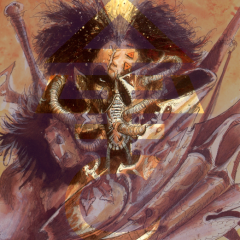
Honor Shield of Brule Onathemes (the Spear-Slayer)
Ioldanach commented on Ioldanach's blog entry in The Avenging Lions Chapter
I have been remiss in giving a disclaimer/explanation about my Legion mini-me's name. Brule the Spear-Slayer is straight up lifted from Robert E. Howard's stories about Kull. Kull, an exile from Atlantis, was the king of Valusia in the age before the Hyborian Age, before the Fall of Atlantis, before Howard's more well-known character, Conan. Brule was a Pictish warrior and a companion, of sorts, to Kull. I chose that name as my display name when registering for the B&C, and carried it over into the concept of the "mini-me." Though I later changed my display name to "Ioldanach" (which derives from Celtic mythology and which will never be a suitable Legio mini-me since I'm using it much more appropriately for my Anhrathe), I have preserved the Brule character as my Legio mini-me. So this is a sort of plug for REH's Kull stories. If you have any affinity whatsoever for Conan and the swords & sorcery genre, but you haven't yet read any of the Kull stories, go and find them. And then you'll understand why I chose the Brule character.- 1 comment
-
- Avenging Lions Chapter
- Legio Bolter & Chainsword
-
(and 1 more)
Tagged with:
-
 ZeroWolf reacted to a post in a topic:
What are the main barriers to updating your blog? (Blog owners only)
ZeroWolf reacted to a post in a topic:
What are the main barriers to updating your blog? (Blog owners only)
-
 Brother Tyler reacted to a post in a topic:
What motivates you to continue to update your blog? (Blog owners only)
Brother Tyler reacted to a post in a topic:
What motivates you to continue to update your blog? (Blog owners only)
-
Keeping in mind that my current blog efforts so far have been focused around consolidating all of my old projects, my feedback may be a little skewed here. I have to admit that my hobby time is hit or miss and all of my projects have stalled because of other non-hobby commitments. Despite that, I really would like to bring my hobby projects - mostly DIYs - to life on the tabletop. If nothing else, I'd like to have a kill team for each of my DIYs eventually. Since I'm revisiting projects that stretch back for years, finding the original discussions required some searching. It wasn't difficult to find each of the old discussions, but it wasn't as easy as I would have liked. I recall seeing some members using their names as tags at one point. At first I thought it was kind of arrogant - I wondered why they thought I would want to read about them. I clicked on a few of them on a whim once, however, and I came to the conclusion that they were using their names as tags as a way to find their posts (and I mentally apologized for my initial ill thoughts about them ). Even though I came to see the value in the practice of using one's name as a tag, I never pulled the trigger on doing that to my own topics. Once I found the blogs, I realized I didn't need to do that - I could just consolidate the projects into the blogs. I doubt that everyone else will want to do that, but some members might (and I highly recommend it). Now all I have to do to find my various projects is open my blog and everything is there, no matter how old (and unfinished ). This keeps me from forgetting things, maintaining visibility of my projects. I've also taken a little time to look at other members' blogs and I'm blown away. I have found them to be inspiring in many ways and I hope to achieve similar levels of craftsmanship (if only I could get some models painted!). I think that the blogs have really given the community a great feature for sharing their hobby efforts - almost like everyone having their own mini-website about the hobby without the pain of having to create and maintain (and pay for) an actual website.
-
The main barrier I have in updating my blog is a lack of hobby time. That has affected all of my participation here, not just with blogs. I'm slowly trying to carve out more time for the hobby and I am fairly certain that the blogs will be my focal point when it comes to my own projects. Some of the discussions are interesting and informative, but others are just other peoples' opinions and they don't necessarily help me much (just as my opinion doesn't really help them, I suppose). The blogs have really given me a way to focus my hobby efforts and plans - if only I had more time.
-
 ZeroWolf reacted to a post in a topic:
How easy is it to create and update a blog on the B&C? (Blog owners only)
ZeroWolf reacted to a post in a topic:
How easy is it to create and update a blog on the B&C? (Blog owners only)
-
Thanks for inviting me into the club! I have found the process of creating and updating my blog and blog entries to be very easy. Creating/composing a blog entry is virtually identical to creating/composing a discussion topic/reply, so there was no real learning curve aside from one thing. One element of the blog entries that was new to me was the image that appears at the top of each entry. It wasn't difficult to come up with images, but it often required me to edit existing images from my articles. I finally figured out that I should take a screenshot of a blog entry to get the right dimensions, deciding upon 1288 pixels wide by 300 pixels high. If I used a smaller image, the system automatically stretched it and I couldn't really control which portion of the image displayed. By having an image prepared, I was able to exercise a bit more control. This is something that I would have loved to have known when I first started working on blog entries, though it wasn't difficult to figure out and it didn't really hamper my efforts much. For what it's worth, aside from my introduction entry, I've been using my blog to consolidate all of my old DIYs. I haven't yet reached the point where I'm creating truly new stuff, but I hope to do that in the future. So I suspect my feedback will be a bit skewed because I'm not really looking for feedback or engagement at this point (not that I wouldn't love to get any, of course, but most of these posts received feedback from other members back when they were first posted in the forums).
-
Echoes in the Warp +++ INCOMING MESSAGE +++ +++ DECRYPT CYPHERS ORDER ACCEPTED +++ +++ PRIORITY ALPHA-1 +++ TRANSMITTED: Macragge RECEIVED: Wrath of Ventanus, Magog Cluster DATE: 6405707.M38 TELEPATHIC DUCT: Librarium-terminus Marcelius SUBJECT: Request for forces THOUGHT FOR THE DAY: The drums of war call out to you Rogue Trader vessel Torchbearer, Captain Subicere commanding, to explore space hulk designated Herald of Misery near Anguis Cluster Herald of Misery previously located near Chinchare sub-sector 698.M35 Indomitus [ref. Task Force Megaeros/Tisiphone] believed component of Herald of Misery Matter urgent [ref. Corrigere Sanction] Ultramarines unable to provide forces due to Brasidas Crusade Can Inceptors fulfill Corrigere Sanction? +++ MESSAGE ENDS+++ +++ INCOMING MESSAGE +++ +++ DECRYPT CYPHERS ORDER ACCEPTED +++ +++ PRIORITY ALPHA-3 +++ TRANSMITTED: Wrath of Ventanus RECEIVED: Macragge DATE: 7419707.M38 TELEPATHIC DUCT: Librarium-terminus Vindicel SUBJECT: Request for forces THOUGHT FOR THE DAY: We obey the teachings of the Primarch Inceptors will fulfill Corrigere Sanction Coordinating instructions requested +++ MESSAGE ENDS+++ +++ INCOMING MESSAGE +++ +++ DECRYPT CYPHERS ORDER ACCEPTED +++ +++ PRIORITY ALPHA-3 +++ TRANSMITTED: Macragge RECEIVED: Wrath of Ventanus, Magog Cluster DATE: 4523707.M38 TELEPATHIC DUCT: Librarium-terminus Marcelius SUBJECT: Request for forces THOUGHT FOR THE DAY: Let no one dishonor your past Minimum sized force needed Condition force per Corrigere Sanction protocols If able, recover evidence Rendezvous with Torchbearer at coordinates P9 456/A4 4551707-4559707.M38 +++ MESSAGE ENDS+++ +++ INCOMING MESSAGE +++ +++ DECRYPT CYPHERS ORDER ACCEPTED +++ +++ PRIORITY ALPHA-3 +++ TRANSMITTED: Wrath of Ventanus RECEIVED: Macragge DATE: 7530707.M38 TELEPATHIC DUCT: Librarium-terminus Vindicel SUBJECT: Request for forces THOUGHT FOR THE DAY: The mistakes of the past will be cleansed in fire Squad Praetus, Venerable Brother Praetus commanding, dispatched Squad Praetus conditioned in accordance with Corrigere Sanction protocols, trigger “Sanctitas” Will relay result of mission +++ MESSAGE ENDS+++ +++ INCOMING MESSAGE +++ +++ DECRYPT CYPHERS ORDER ACCEPTED +++ +++ PRIORITY ALPHA-1 +++ TRANSMITTED: Wrath of Ventanus RECEIVED: Macragge DATE: 7826707.M38 TELEPATHIC DUCT: Librarium-terminus Vindicel SUBJECT: Sanctitas Mission THOUGHT FOR THE DAY: Look to the Codex Astartes for guidance Sanctitas mission successful Indomitus rectified Corrigere Sanction targets recovered Wrath of Ventanus en route to Macragge, estimated arrival 7943707.M38 Summon oath-bound for conclave +++ MESSAGE ENDS+++
-
- Accusers Chapter
- Ultramarines Successor
-
(and 2 more)
Tagged with:
-
Homecoming Astinax knelt before the Primarch, head bowed in veneration. None would ever mistake him for a handsome man, and it is doubtful that he would have been handsome had his body been allowed to develop naturally instead of being subjected to the process by which the Legiones Astartes were made. His one remaining eye was closed, the other having long since been replaced by an augmetic eye after being lost to the blade of a traitor of the VIIIth Legion in the Battle of Tsagualsa. The replacement eye glowed a deep mechanical blue within a metallic frame from which several small wires ran down into his armor. The flesh of his exposed head was a mass of scars and re-grown tissue, mostly discolored. The broad nose bore the signs of having been broken on multiple occasions, and upon his brow were two implanted studs, one a silver Aquila and the other a bronze skull. Once a youth on Macragge, he had served within the XIIIth Legion since the Primarch was discovered by the Emperor. He had foregone having any additional studs implanted since the Second Founding had taken place and he had left the XIIIth Legion to lead his own Chapter. He cradled his helmet in his right arm and from beneath the cloak that covered his left side a scabbarded sword was held, armored hand resting upon the pommel. Both the cloak and transverse crest of the helm were the deep crimson that signified the officers within his Chapter. Though the left pauldron was covered by the cloak, the right was visible and upon its dark crimson field was a golden Aquila within a silver laurel, the insignia of his rank as Chapter Master. The rest of his armor was a pale yellow. Upon its surface were various silver carvings and inlays, the decorations telling the tales of his battles while covering the scars of those battles at the same time. The last time he had knelt before the Primarch was a century prior. Then, too, he had held the title “Chapter Master,” though his armor had been cerulean blue instead of the pale yellow that he now wore. On that august occasion the sword he now held had been bestowed to Astinax, a symbol of the bond between Primarch and Chapter Master. The weapon originated from Talassar and the decorations upon the ruddy scabbard commemorated the victory of the Legion over the Orks upon Glaudor, a campaign in which Astinax had lost his right arm in single combat against a hulking Ork. There was no conversation with the Primarch on this occasion, however. The Primarch’s unmoving form lay in stasis, a mortal wound across his neck from the blade of one of his demigod brothers. Ignoring the honor guard of Ultramarines terminators that surrounded the Primarch, Astinax looked upon his Primarch like a dutiful son grieving over his father. Others waited within the Temple of Correction, patiently keeping their distance. As Chapter Master, it was Astinax Megaeros’ prerogative to pay reverence before the other members of his Chapter. To the rear of the temple stood the senior officers of the Chapter, including the Chapter Warden and the High Chaplain. These officers, too, had fought alongside Roboute Guilliman as members of the Ultramarines Legion, and now fought in the colors of the Accusers Chapter under their chapter master, the Custodian, Astinax Megaeros. These Adeptus Astartes stood respectfully and silently, stoically waiting for the chapter master to complete his viewing. When Astinax finally completed his reverie, he stood slowly, releasing the scabbard to hang at his side. He then turned and walked to an alcove while his officers approached the dais in order to pay their own respects to the Primarch. His gaze fell upon the delegation that awaited him. There were five of them, each an augmented transhuman member of the Adeptus Astartes. Two were dressed in simple white robes while three others wore power armor from different chapters. Astinax bowed his head as he reached the group, and one by one each of the five bowed his in return. For long moments the six silently regarded each other, the gravity of the situation palpable. Finally, one of the robed figures spoke, “It is good to see your ugly face again, brother, even if it is under these circumstances.” Astinax suppressed a grin, “You were always too pretty for fighting, Antilochus. Tell me, brother, who will lead the Ultramarines now?” Antilochus shrugged his broad shoulders slightly, “I don’t know, brother. The Chapter Council is consulting the Codex Astartes. The choice seems obvious, but we obey the teachings of the Primarch even in these days.” “And the Legion?” continued Megaeros. “My brother, the Legion is no more. Our father disbanded the XIIIth Legion into the Chapters so that the Warmaster’s treachery could never be repeated. Though we have fought together since that day, I suspect that Tsagualsa and similar events will not be repeated.” At the mention of the attack on the Night Lords’ world, Astinax reflexively reached up with his free hand to touch the metallic housing of his augmetic eye. His gauntlet clenched into a fist a moment later and he lowered it to his side. Astinax looked to his Primarch again, remembering the puissant lord’s brilliance at that momentous battle. After a few moments Astinax continued, “They will pay for this. My brothers and I will not allow those that did this to our father to go unpunished.” “Patience, brother,” cautioned one of the others. “Your devotion to the Primarch is well known, but this is not the time for rash actions.” Astinax turned to regard the new speaker. This one, too, was in battle armor, though of a blue and white quartered livery with a haloed skull upon the shoulder. “As always,” answered Astinax, “your words are filled with wisdom, Lucretius. Have no fear. My brothers and I will not rush headlong into a fight we cannot win.” Astinax looked back at the Primarch. By this time, the senior officers of his chapter had finished. The rest of the chapter was filing by in turns, starting with the veterans of the First Company. As each squad of warriors reached the viewing point, they faced the Primarch, removed their helmets, and knelt in unison. They remained kneeling for a period of time, heads bowed and eyes closed in reverent silence. Once completed, they stood, faced about, donned their helms, then marched away as the next squad moved into position. Astinax and the other chapter masters watched this sequence of events unfold several times. Throughout, Astinax mouthed a silent litany, keeping perfect time with his battle-brothers before the Primarch. After several iterations of this ritual, Astinax spoke to his fellow chapter masters. “Do you see the battle-brothers of my chapter there, brothers?” At this, Astinax gripped the scabbard of his blade in his left arm and raised it so that his fellow chapter masters could see it. “Each is renewing the vows he swore upon this blade; the same vow I swore to the Primarch when he gave it to me a century ago.” He paused to watch more of his battle-brothers enact the ritual then turned to face his brother chapter masters. “I have been the custodian of this weapon since that day, and the brothers of my chapter call me by that title, “Custodian” in recognition that I am merely the instrument of our Primarch’s teachings and the Emperor’s vision. While I lead the Accusers, greater loyalty is owed to the Primarch and the Emperor. The Accusers will not rest while our treacherous brothers go unpunished.” He turned to face the other chapter masters before saying, “Tonight we grieve for our fallen Primarch. On the morrow we will grieve no more and at dawn the Chapter fleet will depart for the Maelstrom where we have located one of the hidden bases of the Twentieth Legion. This sword,” he said, raising the weapon high, “will be the tempest of the Primarch’s wrath upon those that know no loyalty.” At these words, the countenance of Astinax became set with grim fury and all those assembled knew that there was no further point in trying to restrain their bellicose brother. All had sworn similar oaths, the only real difference being in how each intended to pursue the vendetta against the traitors. One by one, each acknowledged the pledge by making the sign of the aquila – the chapter master of the Silver Eagles first, followed by Nemesis, and so on until each had saluted their brother of the Accusers Chapter. Accepting the salutes of his brothers, Astinax lowered his weapon and turned without a word to once again watch his chapter pay its respects to the Primarch. Little did Astinax Megaeros of the Accusers Chapter know that when his chapter departed the next day, he would never again see the planet of his birth, Macragge.
-
- Accusers Chapter
- Ultramarines Successor
-
(and 2 more)
Tagged with:
-
False Interpretation of the Namis Arkaid Among the items recovered from the fortress of Inquisitor Lerneaus was a sheet with a few brief notes on it. The scrap of paper was entrusted into the care of Inquisitor Lord Naukara, who transferred it to the Order of the Sacred Oath on Holy Terra for evaluation. +++ Date: 2006791/M38 +++ Ref: OM/32099147/ED +++ By: Sister Sarojini, Order of the Sacred Oath, Convent Prioris, Holy Terra +++ To: Inquisitor Lord Naukara +++ Re: Inquisitor Lerneaus +++ Thought: The strong are strongest alone Inquisitor Lord, The document you forwarded has been evaluated as you instructed. This document is a passage from the "Namis Arkaid" which is an obscure epic poem originating from the Memnos system in the Segmentum Obscurus. The Memnos system was brought back into the light of the Imperium in M35 by the Imperial Fists Chapter of the Adeptus Astartes, who discovered a lost pocket of humanity upon a world that had been obscured by intermittent Warp storms. As the inhabitants of the system were brought into compliance with the Imperium and the Imperial Cult, this epic poem was studied. As far as could be determined, the humans upon Memnos V were the remnants of a colony pre-dating the Wars of Unification. In the thousands of years that they had been separated from the rest of the species their culture and technology had debased to pre-industrial levels. Situated near the Eye of Terror, the population suffered minor levels of mutation and were frequently attacked by the nightmarish denizens of that region of space. The more egregious strains of mutation were culled when the population was brought into compliance, though the percentage of psykers was higher than normal and was sufficient to provide for the needs of the Emperor. When the Dominion of Fire took place, the forces of the Great Enemy overran the world. Those that weren't destroyed were enslaved and worship of the Dark Powers spread. The world was later cleansed in the aftermath of the Dominion of Fire and is no longer habitable. The "Namis Arkaid" was said to be an epic poem re-telling the key events of one of the many wars against the Dark Born (which appear to have been some form of Chaos servants). In this poem the world is attacked by the warriors of the Dark Born, only to be rescued by the intervention of the "son of Meleus" who is described as a champion from the stars. This poem is thought by most Imperial scholars to be either epic myth or a form of prophecy. The latter seems more likely as the Imperial Fists recorded significant battles against renegades in recovering Memnos. The version of the poem that Inquisitor Lerneaus studied was the Calmain translation of M37. This translation was not well-received by most Imperial scholars. One of the most interesting elements of this translation, though, was that the scribe Calmain wrote both the original and translated forms side-by-side. In this, he inspired the later Arkues and Fitzimoor translations (the former considered the definitive translation). The passage in question is translated somewhat differently in both the Arkues and Fitzimoor translations, so the use of the Calmain translation by Lerneaus was deliberate as it allowed for certain alternative interpretations that may have supported the renegade's objectives. If Inquisitor Lerneaus' notes are interpreted correctly, he speculated that the poem was actually a documentation of the involvement of the Accusers. That line of speculation seems highly unlikely, though, as even the elements that he uses to support it are inconsistent with the known facts. If we assume that the Megaeros in question was Chapter Master Megaeros of the Ultramarines Legion, whether or not the description of him as the "Son of Meleus" is unknown as the records of that ancient Space Marine have been lost to time. Meleus itself is a name that occasionally appears in Macraggian male citizens, though, its use is very rare and it is considered archaic. Similarly, the parentage of the Great Crusade era Space Marines named Meleus (from the Iron Hands and Alpha Legion) is also unknown. It is interesting to note that the name Meleus was known to be used in the Iron Warriors Legion, with at least two battle-brothers of that legion bearing the name. Likewise, "Champion of Terre" would seem to imply someone that was from Holy Terra or fought at the great Siege of Terra during the Horus Heresy. Regardless, we can't specifically tie a "Son of Meleus" to any specific legion or individual Space Marine. The reference to a "champion of Terre" and "fabled Sol's war-like child" is also interesting as it implies that the individual to whom it refers was based at Holy Terra (likely the Imperial Fists Legion, the Adeptus Custodes, or perhaps an older member of one of the legions pre-dating the re-discovery of the Primarch of that legion). Alternately, it could be one of the heroes of the Siege of Terra (again, the Imperial Fists Legion, though the Blood Angels and White Scars Legions also fought at that great and terrible event). Neither the Ultramarines nor Iron Hands Legions were present at that battle. A more sinister interpretation might be that the Namis Arkaid is actually describing traitor Space Marines, twisting the views of a "champion of Terre" to a renegade. This might explain the higher levels of mutation that were discovered upon that world when the Imperial Fists Chapter finally brought it into compliance. Regardless, the singular lack of any records on a Chapter named "Accusers" and wholly speculative nature of Inquisitor Lerneaus' notes serve to completely undermine his arguments. The only other documentation the Order has for that Chapter is the Insignium Astartes Anguis, though that has by this time been proven to be a forgery. Based upon the proof of Inquisitor Lerneaus' subornment by the Alpha Legion, this fragment would appear to be an example of his efforts to plant seeds about the existence of the Accusers Chapter in preparation for some plot by the traitor Legion. The fragment of the Namis Arkaid has been placed in the Telemus Archive under guard by Sisters of the Order of the Argent Shroud. Sister Sarojini
-
- Accusers Chapter
- Ultramarines Successor
-
(and 2 more)
Tagged with:
-
The Hidden Meaning? Milord, I conducted a study of the book as instructed. There were faint traces of the energy of the Empyrean upon the book, but these could very well have stemmed from the book having been aboard a space hulk and likely exposed to the Sea of Souls for some duration. Certainly there were no hidden writings or patterns that established any sort of link, no matter how small, with the Warp. However, I found the page in question most curious. While it shows what appears to be the standard imagery of any Chapter of the Adeptus Astartes, I wonder if there is some hidden meaning. I've drawn the image below for clarity: The symbol looks innocent enough - the golden eagle's head granted in heraldry to those who provided some service to the Immortal Emperor (praise Him!) superimposed over a white halo that is derived from several awards common within the Legiones Astartes during the Great Crusade. If you look deeper, though, the image may have some blasphemous meaning. The eagle's head draws the viewer's attention, implying holiness through the association of that image with the Emperor (may He rule forever). However, the design of the halo is reminiscent of heretical glyphs associated with the dark powers. The juxtaposition of the two elements draws upon similar heresies espoused during the Bollen Schism [M35] and needs no explanation. I must concur with the Adepta Sororitas assessment that the document is a hoax and conclude that it is intended to mislead the reader into thinking that such a Chapter actually existed. I can only speculate as to who may have crafted such a ploy and for what purpose, though it seems readily apparent that these are the machinations of the servants of the Great Enemy. Who knows what calamity might befall us should this book fall into the wrong hands? I most humbly, yet urgently, recommend that we destroy the book immediately. Your most obedient servant, Archivist's Note: This transcript is from a document recovered from the wreckage of Inquisitor Lerneaus' fortress after Inquisitor Lerneaus was declared Extremis Diabolus and executed by a cell of the Ordo Malleus led by Inquisitor Lord Naukara in 791.M38. The report appeared to have been deliberately damaged so as to conceal the signature and name of the author. The Insignium Astartes Anguis was not recovered and was presumed to have been destroyed, though one pict capture of a fragment remains preserved within the archives of the Order of the Sacred Oath, Convent Prioris, on Holy Terra.
-
- Accusers Chapter
- Ultramarines Successor
-
(and 2 more)
Tagged with:
-
Forgery! +++ Date: 4029709/M38 +++ Ref: Ast/38571391/INS +++ By: Sister Sarojini, Order of the Sacred Oath, Convent Prioris, Holy Terra +++ To: Inquisitor Lerneaus +++ Re: Anguis Codex +++ Thought: Trust no one else, and trust yourself less. Inquisitor, I have completed my initial evaluation of the codex you entrusted unto my care. The codex is not an abridged version of the Codex Astartes, as was initially thought. It is instead a form of insignium - a handbook about uniforms and regalia. Focusing on the Adeptus Astartes, this insignium would properly be referred to as an Insignium Astartes, and we have further identified this insignium based on the location of its discovery, Anguis. A number of characteristics point to this insignium dating from the early years of M31. Chief among these is the Chapters of the Adeptus Astartes that are depicted within. While over half of the pages are damaged and/or decayed to the point where the material is no longer legible, the pages that can still be read either partially or in their entirety all portray Chapters known to have been created in the 2nd Founding (with one notable exception that I'll cover later). In and of itself this might not be conclusive as similar codices have been created during some of the foundings in order to catalogue the Chapters created during those foundings, though this has been far from a universal practice and the accuracy of these codices has varied. Another characteristic pointing towards M31 is the style of the embellishments that decorate the insignium. Chief among these is the decorative bars that separate certain elements of information, the bars being augmented at each end with small vertical hashes, with the top and bottom of the hashes and the ends of the bars forming stylized versions of a cross motif that was commonly used by Imperial forces during the Great Crusade. This style of decoration fell out of favor during the latter half of M31, and though it has occasionally been used over the years, such uses have been very rare and have generally been tied to emulations of written works from the Great Crusade. The cover of the codex also points to an origin some time in M31. The lettering style used on the cover and as titles of pages was common during the rebuilding of the Imperium after the Great Heresy, used most commonly by Terran scribes through about 300.M31. In addition, the gold filigree upon the cover depicts scenes of battle that appear to be smaller renditions of scenes from the time known as the Scouring, the years immediately following the defeat of the Warmaster as the still-loyal forces of the Imperium fought to destroy the remaining traitor forces and recover territory lost to the traitors and other forces when the Warmaster broke faith with the Emperor. The style of writing and formatting within the insignium bear a strong resemblance to the second version of the Gant Manuscript within the Ceris Archive and it appears to have been written by the same hand. Certain phrases are common between the two books, further pointing to both similar authorship and date of origin. However, deeper investigation leads me to suspect that the insignium is a clever forgery. I mentioned previously that all but one of the Chapters that can be seen in the insignium are known to be from the 2nd Founding. The one exception is the Accusers Chapter. There are no other records of such a Chapter ever existing - no Chapter listings in any of the versions of the Codex Astartes or other insigniums include the Accusers, nor are any Chapters known to have used the livery portrayed for that Chapter in the insignium. The entry implies that the Accusers were created from the Ultramarines Legion, making them one of the Primogenitor ("First Born") Chapters. This is supported by several phrases most often used to indicate the various Primogenitors, including: + "true son of Macragge" (indicating that the Chapter Master was born on Macragge) + "disciple of the Primarch's teachings" (indicating that the Chapter Master was fully indoctrinated in the Codex Astartes) Though records are scant, I found records of three members of the Adeptus Astartes named "Megaeros" from the time of the Great Crusade. There was a Commander Megaeros of the Ultramarines Legion, but the limited records we have indicate that he was killed in action during the Scouring, those records being the posthumous awarding of the Comminus Imperator. The other two were from other Legions (Sergeant Megaeros of the Iron Hands Legion is thought to have been killed during the drop site massacres on Isstvan V; and a Captain Megaeros is mentioned in the annals of the Alpha Legion, though his fate is unknown). Of the ships named in the text, there are no records of the Ultramarines Legion operating a battle-barge named Indomitus; and the Guilliman's Charter belongs to a Chapter created during the 3rd Founding. Two of the strike cruisers, the Contus and Cruciare, fought under the flag of the XIIIth Legion. There are no records of an Ovatio Tonare belonging to the Ultramarines, but the Battle of Tonare was fought during the Scouring, so the vessel may have been either commissioned or re-named subsequent to that battle. Since many records were lost during the reign of Goge Vandire, I also resorted to requesting from some of the Primogenitor Chapters any information they might have on a Chapter named the Accusers. Most of the Chapters didn’t even answer my appeal, including the Inceptors, Aurora Chapter, Novamarines, and Genesis Chapter. Only two of the Chapters responded: the Praetors of Orpheus and the Doom Eagles. Both of these Chapters provided curt answers that they had no records of such a Chapter ever having existed. Assuming these responses were accurate, the information contained in the Insignium Astartes Anguis appears to be highly suspect. The lack of cooperation on the part of the Adeptus Astartes was expected, however, and I suggest that a visit to the Chapters in person might garner a response where an astropathic appeal failed. If you choose to pursue this, I recommend the Praetors of Orpheus and Ultramarines as they have proven to be the most approachable. Another fact to consider is the existence of a servant of the Dark Powers colloquially known as "the Accuser." This being was first identified by the Praetors of Orpheus Chapter during the Nova Terra Interegnum, though there have been several reports of this individual since that time. Most recently, a combined Novamarines/Praetors of Orpheus force faced the Accuser during the Skilthras Wars early in this millennium. This fell warrior did not wear armor colored as the Accusers in the insignium, instead wearing armor of deep black. This warrior led a force comprised primarily of Alpha Legion Chaos Space Marines. Though the identity of this creature has never been identified, there is a strong possibility that he is the former Alpha Legion Captain Megaeros. This codex has been labeled as the Insignium Astartes Anguis and is tentatively identified as a forgery pending further investigation. I am at your disposal should you decide to appeal directly to the Chapters of the Adeptus Astartes in this matter. Sister Sarojini
-
- Accusers Chapter
- Ultramarines Successor
-
(and 2 more)
Tagged with:
-
 Domhnall reacted to a blog entry:
The Mystery Begins
Domhnall reacted to a blog entry:
The Mystery Begins
-
 W.A.Rorie reacted to a blog entry:
The Mystery Begins
W.A.Rorie reacted to a blog entry:
The Mystery Begins
-
 Ioldanach reacted to a post in a topic:
=][= THE WINDS OF CHANGE =][=
Ioldanach reacted to a post in a topic:
=][= THE WINDS OF CHANGE =][=
-
 Ioldanach reacted to a post in a topic:
=][= Banner of the Month - January 2025 =][=
Ioldanach reacted to a post in a topic:
=][= Banner of the Month - January 2025 =][=
-
Fragment of a document reportedly recovered from the space hulk designated Herald of Misery in M38 by the rogue trader Ibram Subicere: Accompanied by a demi-squad of the Inceptors Chapter, Captain Subicere and his crew aboard the Torchbearer were exploring the Anguis Cluster near the Maelstrom. There they discovered the Herald of Misery. Auspex readings indicated that the vessel was comprised of several major vessels and a number of smaller ones, including a few Imperial vessels and pre-Imperial human vessels. The Inceptors boarded the hulk in terminator armor, establishing a lodgment from which Captain Subicere and his crew could salvage while the Space Marines explored the deeper reaches of the hulk. Two days into the operation, Brother-Sergeant Praetus and his squad suddenly returned. Putting his battle-brothers on guard, Brother-Sergeant Praetus returned to the Torchbearer. He privately entered the astropath’s quarters, ignoring all questions from Captain Subicere, and returned to the space hulk. He said one word to his battle-brothers: "Sanctitas." At this word, the terminators left their posts and returned whence they came, each carrying loads of demolitions. Brother-Sergeant Praetus then informed Captain Subicere that his squad had discovered a grave threat within the depths of the hulk. He and his squad were to destroy the threat by planting demolitions at structural weaknesses within the hulk, during which time Captain Subicere and his crew would have five hours to recover as much as they could before returning to the Torchbearer. At this, Brother-Sergeant Praetus turned and followed his battle-brothers into the depths of the hulk. One of the items that Captain Subicere was able to retrieve from the hulk was a small book. Beneath a thousand years of dust, the leather-bound book was decorated with gold filigree and the aquila of the Imperium. On the pages within, Subicere saw pictures of different Chapters of the Adeptus Astartes, a small guidebook to the names and liveries of over a hundred Chapters. Instinctively, Subicere kept the book secret from Brother-Sergeant Praetus and his Space Marines, locking the book within his private sanctum aboard the Torchbearer before the Space Marines returned from their mission. When Brother-Sergeant Praetus and his battle-brothers returned from their mission, they were laden with two containers they’d recovered from within the Herald of Misery, two of the terminators immediately returning to the Torchbearer with the containers as Brother-Sergeant Praetus and the two remaining battle-brothers remained, ostensibly to provide security as Captain Subicere and his crew completed their own tasks. Once all hands returned to the Torchbearer, Brother-Sergeant Praetus directed Captain Subicere to move the Torchbearer to stand-off distance. From there, the veteran Space Marine command-detonated the demolitions, entirely destroying the central vessel of the hulk and sending the debris of a dozen other vessels scattering through the void. He then informed Captain Subicere that the Inceptors had recalled the demi-squad and that they must return to the Chapter immediately. No explanation was given, and Captain Subicere was more than happy to see the Space Marines depart. Upon completing the exploration of the Anguis Cluster, Subicere and the Torchbearer returned to Terra where the book was dutifully handed over to Inquisitor Lerneaus of the Ordo Malleus. The Inquisitor found one page, pictured at right, puzzling and required expert investigation, so he forwarded it to the Order of the Sacred Oath, an Order Dialogus of the Adepta Sororitas, for study and authentication.
-
- Accusers Chapter
- Ultramarines Successor
-
(and 2 more)
Tagged with:
